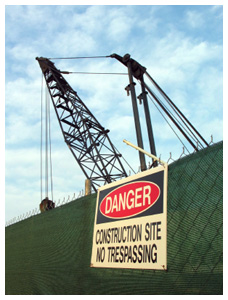 Editor’s note: In part one of this series last week, Jim Kollaer’s article ACT Now on Jobsite Security began as he explained the many areas of jobsite security which must be covered to protect the job, the workforce, and the owner’s interests. He introduced one way to remember three key jobsite security items: ACT. Access, Control and Technology are all important components of a secure construction site.
Editor’s note: In part one of this series last week, Jim Kollaer’s article ACT Now on Jobsite Security began as he explained the many areas of jobsite security which must be covered to protect the job, the workforce, and the owner’s interests. He introduced one way to remember three key jobsite security items: ACT. Access, Control and Technology are all important components of a secure construction site.
Access
Access for the workers, equipment, and materials you need to build the project is key to the security of your jobsite and is the first step in your plan.
Workers – It is mandatory that you know who is on your jobsite whether on your crew or working for one of your subs at all times. It is critically important that you not let unsafe, drug or alcohol impaired or unqualified workers enter the site. It should go without saying that you do not let thieves on your site for any reason. Theft rings are becoming more brazen and sophisticated as the economy recovers. We have seen instances where gangs of thieves dressed in uniforms come on a jobsite, claim to be from the government, steal ID information, equipment and materials, and then leave without ever being confronted.
The only way to keep that from happening is to identify anyone and everyone who comes into the jobsite with a positive ID from a recognized company combined with either a driver’s license, a personal ID, or bio identifier like palm print or iris identification. In order to do that, each worker must go through a single controlled access gate where a designated person or team is charged with keeping rosters, monitoring who comes on-site, knowing which deliveries are scheduled each day, and keeping informed about possible safety and security issues that could impact the jobsite.
Equipment and Materials – Construction equipment is becoming more sophisticated and more expensive, whether surveying stations (favorites of snatch and grab thieves), forklifts and front end loaders (hot “aftermarket” items for jobsite thieves), or the lasers and cranes that are being used on your builds. Thieves are aggressive and are targeting, with some success, those costly items as well as the commodity materials used in construction today. An example is multifamily jobsites where the thieves strip copper tubing out of the cooling system to sell as scrap. Some cities and police departments require that all equipment be barcoded and identified in an inventory, be stored off site, or if stored on site, be incapacitated during the hours when they are not in use. The same goes for equipment used by the crafts. With tracking and location finding systems, “find my phone” is fast becoming, “find my front end loader, and nail gun, and laser.”
Supplies, materials and the trucks that deliver them to your site should be scheduled and logged in and out so that they can be monitored while they are stocking your site. That monitoring goes for the drivers, the helpers, and the workers responsible for unloading the trucks on site as well. Those people talk to their friends and family about what is going on in your site and can be a source of problems if they are allowed to roam freely around site. Sheathing, wallboard, studs, and other bulk materials should be marked and identified so that they can be found should they be stolen from your site. Irvine, California and other cities require such identification as part of their security planning to reduce materials theft on construction jobsites in the city. Limiting the access points into the site is a first critical point in your ACT jobsite security plan.
Next week, Jim Kollaer’s article ACT Now on Jobsite Security will continue as he explains the second key to jobsite security: Control.
ACT Now on Jobsite Security, Part 2 of 4
by Jim Kollaer | December 11, 2013



Add new comment